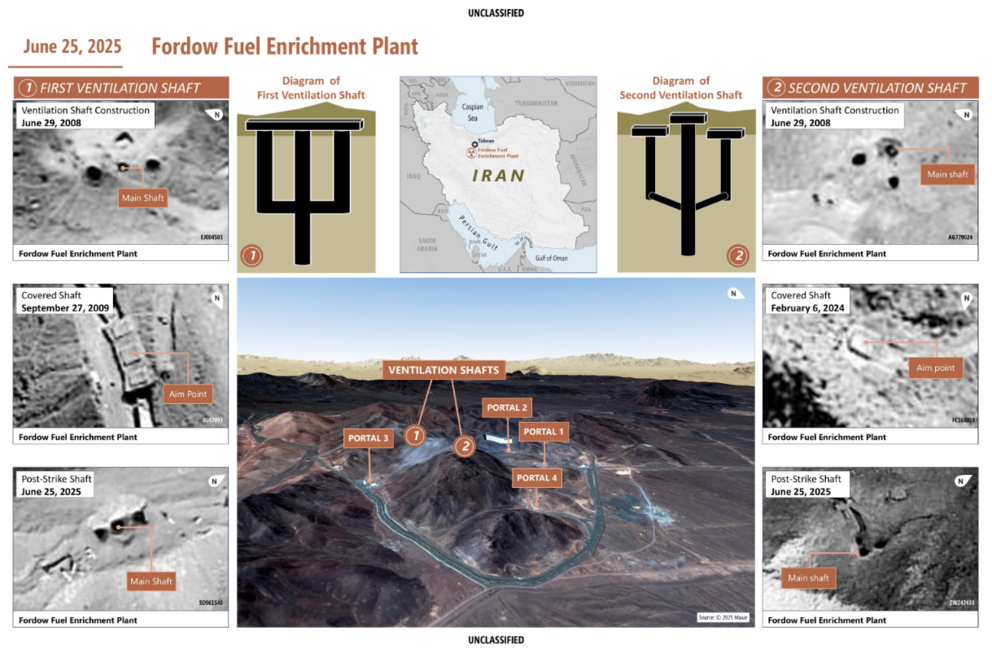The secret 15-year plan behind US strikes on Iran
Clandestine Pentagon program developed the bunker buster bombs specifically to take out Iran’s nuclear program.

A June 25, 2025, poster from the Defense Threat Reduction Agency (DTRA) shows unclassified aerial images of Iran's Fordow Fuel Enrichment Plant’s two ventilation shafts during construction in 2008, post-construction in 2009, and after the June 21, 2025, strike. According to Joint Chiefs of Staff Chairman Gen. Dan Caine, two DTRA employees spent years analyzing the site's geology, construction materials, and equipment to model the facility and develop a strike plan. The Pentagon
By Ryan Morgan
WASHINGTON—The United States’ B-2 stealth bomber strike on Iran’s Fordow uranium enrichment facility was the culmination of more than 15 years of study and planning, according to Chairman of the Joint Chiefs of Staff Gen. Dan Caine.
Caine joined Defense Secretary Pete Hegseth for a press briefing on June 26, in which the defense secretary said the June 21 bombing mission was a resounding success that set Iran’s nuclear development back by years.
Caine detailed the military planning that began in 2009 to design a purpose-built method to knock out the Fordow facility, which is buried hundreds of feet underground in a mountainous region of Iran.
A Briefing in a Vault
Caine shed new light on the role of the Defense Threat Reduction Agency (DTRA), an organization tasked with preparing bespoke solutions to destroy highly sensitive targets, including emerging weapons of mass destruction.
“DTRA does a lot of things for our nation, but DTRA is the world’s leading expert on deeply buried, underground targets,” Caine said.
“In 2009, a Defense Threat Reduction Agency officer was brought into a vault at an undisclosed location and briefed on something going on in Iran,” Caine said, declining to identify the DTRA officer by name.
This DTRA officer, and another unnamed member of the agency, were then tasked to work with the intelligence community to study the construction of the Fordow site.
“For more than 15 years, this officer and his teammate lived and breathed this single target: Fordow, a critical element of Iran’s covert nuclear weapons program,” Caine said.
The two DTRA employees spent years studying everything from the geology surrounding Fordow, to the construction materials and other equipment arriving at the facility, so they could model the site and devise a plan.
“They literally dreamed about this target at night when they slept,” Caine said.

A satellite view shows an overview of the underground Fordow Fuel Enrichment Plant, after the U.S. struck the nuclear facility, near Qom, Iran, on June 22, 2025. Maxar Technologies/Handout via Reuters
Bespoke Bombs
In the course of their study of the Fordow facility, Caine said the pair of DTRA employees leading the project soon determined the U.S. military did not have a weapon that could adequately address the challenge the fortified Iranian nuclear facility presented.
“So, they began a journey to work with industry and other tacticians to develop the GBU-57,” Caine said.
The GBU-57, also known as the Massive Ordnance Penetrator (MOP) or bunker-buster, is a 30,000-pound bomb designed to burrow and explode deep underground.
Military planners then spent years testing the bomb, specifically for the Fordow facility.
“They tested it over and over again. ... They accomplished hundreds of test shots, and dropped many full-scale weapons against extremely realistic targets for a single purpose: kill this target at the time and place of our nation’s choosing,” Caine said.
Each GBU-57 is “bespokely” designed for a specific target. He said each one dropped on the Fordow facility “had a unique desired impact angle, arrival, final heading, and fuse” corresponding to its role in the overall mission.
For the rest of this article please go to source link below.
